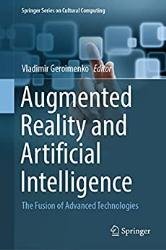 Название: Augmented Reality and Artificial Intelligence: The Fusion of Advanced Technologies
Название: Augmented Reality and Artificial Intelligence: The Fusion of Advanced TechnologiesАвтор: Vladimir Geroimenko
Издательство: Springer
Год: 2023
Страниц: 383
Язык: английский
Формат: pdf (true)
Размер: 11.9 MB
This book is the first research monograph that explores a new research field and practical applications produced by the combined use of two of the most advanced and powerful technologies available in today’s world – Artificial Intelligence (AI) and Augmented Reality (AR). It is written by a team of 50 researchers and practitioners from 16 countries, which has enabled a thorough coverage of emerging or previously unexplored subject areas.
The authors consider practical, theoretical, and cultural aspects of “AI-powered AR” and “AR-enriched AI”, and their usage in a large variety of areas, such as education, medicine, healthcare, dentistry, pharmacy, active lifestyle, smart services, fashion, retail, recommender systems, and several others.
Augmented Reality and Artificial Intelligence: The Fusion of Advanced Technologies is essential reading not only for researchers, practitioners and technology developers, but also for students (both graduates and undergraduates) and anyone who is interested in building a comprehensive understanding of the emerging fields of “intelligent augmented environments” and “Artificial Intelligence presented by Augmented Reality”.
The book’s 19 chapters, which can be read in sequence or randomly, are arranged in four parts as follows:
Part I “Practical, Theoretical, and Cultural Aspects of Integrating Augmented Reality and Artificial Intelligence” includes five chapters (Chaps. 1–5).
Chapter 1 “Mixed Reality and Deep Learning: Augmenting Visual Information Using Generative Adversarial Networks” summarizes the theory of generative adversarial networks (GANs), overviews the evolution of GAN methods that have either been used in published augmented reality research or have a strong potential for future AR work, and presents interesting use cases of GANs in AR. GAN is one of the most innovative Deep Learning techniques. The discussed methods are categorized into three distinct groups that correspond to unrelated bodies of research: GANs for image composition, AR face filters, and 3D model generators.
Chapter 2 “Augmented Reality User’s Experience: AI-Based Data Collection, Processing and Analysis” presents an AI-based approach to the systemic collection of user experience data for further analysis. This is an important task because user feedback is essential in many use cases, such as serious games, tourist and museum applications, food recognition applications, and other software based on augmented reality. For AR game-based learning environments, user feedback can be provided as multimodal learning analytics (MMLA) which has been emerging in the past years as it exploits the fusion of sensors and data mining techniques.
Chapter 3 “Digital Dreams: Speculative Futures for Artificial Intelligence, Augmented Reality, and the Human Brain” explores possible future interactions between Artificial Intelligence and Augmented Reality. Taking an interdisciplinary approach, the chapter considers dreaming in both humans and machines as a lens through which to investigate how future integrations of AI and AR may support both creativity and learning.
Part II “The Educational Use of Intelligent Augmented Environments” comprises five chapters (Chaps. 6–10).
Chapter 6 “Artificial Intelligence, Augmented Reality and Education” proposes several tools based on Artificial Intelligence and Augmented Reality to promote the transmission of knowledge in the educational context. AI is already used to provide assistance as part of educational processes (Squirrel AI, Google Classroom) and can generate effective methodological and assessment resources (Alexa, SIRI, NVIDIA Canvas, WriteToLearn, Lingvist, Duolingo, Gradescope, Smartick).
Chapter 7 “Artificial Intelligence, Machine Learning and Extended Reality: Potential Problem Solvers for Higher Education Issues” investigates the potential of new digital technologies and innovative tools in solving higher education issues.
Part III “Augmented Reality and Artificial Intelligence in Medicine, Healthcare and Physical Activity” consists of five chapters (Chaps. 11–15).
Chapter 11 “Meta-Patients: Using Mixed Reality Patients and an AI Framework for Simulating Life-Like Clinical Examinations” addresses an augmented learning experience created for the Griffith University School of Nursing and Midwifery in 2022.
Chapter 14 “Artificial Intelligence and Augmented Reality in Physical Activity: A Review of Systems and Devices” describes the existing AI devices aimed at PA monitoring and the most relevant AR software focusing on movement.
Скачать Augmented Reality and Artificial Intelligence: The Fusion of Advanced Technologies